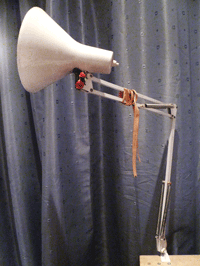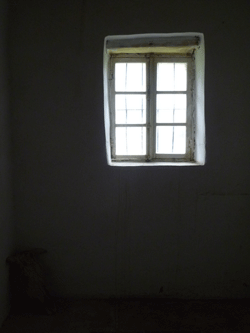Adjustable desk lamps

I'm currently using <cough> three adjustable desk lamps. (Not all at the same time.)
I also use a Lumie SAD light, which I don't think I need for mood improvement, but which is good for regulating sleep and amazing as a work light.
Good lighting is beautiful. And necessary!
Reasons why calligraphers should have (maybe several) excellent light sources:
• Calligraphers and miniaturists need bright clear light so they can see detail and colour correctly and comfortably
• (Related to the above.) Eyesight will suffer from doing artwork in insufficient or uneven light!
• (Also related.) Every light source has a colour, even if it's just 'white', and this colour affects the way that inks, paints etc are mixed and applied to the artwork during production.
Therefore, when you're choosing a desk lamp, consider these three factors: the colour of the light emitted, its brightness and its adjustability. Not always in that order.
Also think about cost, of course. But not at the expense of the other three.
Colour — Every lamp gives off light of a certain colour, and the colour will affect the way you use colours in your calligraphy and artwork. For example, a very blueish-white light source will lead you to mix and choose different colours on your palette than you would use if working under a yellowish light source.
Also, if you display your work in a different light from the one you worked in, the calligraphy (or artwork) will look a different colour, which you didn't intend – this is undesirable.
For this reason, it's important to know what colour 'temperature' your lighting is. ('Warmer' colours are at the reddish-to-yellow end of the spectrum, 'cooler' colours are at the bluer end.) I devote a whole colour temperature page to this topic.
Brightness – Although different people prefer different light levels, it's important to have plenty of light by your own standards so you are working comfortably. For very detailed work in miniature painting, I look for 100-watt daylight bulbs (or the equivalent of 100-watt in eco-friendlier bulbs) — that's 750 lumens. For general calligraphy, 60 watts in an adjustable desk lamp is fine. But the difference between 60 watts and 100 watts is huge when you're trying to paint objects smaller than a millimetre across.
Make sure the lamp you're buying has a good flared surround or else can be directed so it doesn't dazzle you out of the corner of your eye. Corner-of-eye dazzle => headache.
Adjustability (distance, direction) – the best lamp in the world is no good if it's in the wrong place. Similarly, if you want to change position and work on a different part of a large page that's taped down, it's much easier to be able to bring the light towards you than to have to move your work and materials towards the light.
Your lamp should generally be positioned so it casts light onto the page from your non-dominant side. That is, if you're right-handed, it should cast light from the left side and a bit behind, and vice versa, if you're left-handed it should be on the right and behind. This is so your hand doesn't cast shadows onto your work while you're calligraphing (or painting).
Anglepoise (swing-arm) adjustable desk lamps
The beautiful creature illustrated at the top of the page is my own ancient clamp-on adjustable desk lamp, a white anglepoise. It currently contains an inexpensive daylight bulb emitting 60W of coolish blue-white light.
The anglepoise is an iconic version of the swing-arm lamp, which is one of the handiest designs of light ever invented.
Clamp anglepoises like this are ideal in that they can be fixed to almost any desk or table, so the lamp base takes up very little space and it's stable. But the overwhelming virtue of anglepoise lamps is that the light angle and distance are very easily adjustable in a wide range, which is important for any artwork including calligraphy and miniature-painting.
Anglepoises are not always cheap but something like the one above is a worthwhile long-term investment. Google around for bargains or check regularly in your local charity shops/thrift stores. Make sure the vendor provides an up-to-date electrical safety check for any second-hand electrical item.
My second adjustable desk-lamp is for the other desk, which has solid sides so I can't clamp on a standard anglepoise. This regular desk lamp has a large, heavy base, which isn't as convenient and space-saving as a clamp, but it works. It's got a normal, old-fashioned, incandescent light-bulb in it, which is super-yellow.
Still not convinced? :-)

Typical bad lighting includes light that is dim or dull (many low-energy bulbs), flickering or 'shimmery' (fluorescent bulbs), patchy or uneven (from many non adjustable desk lamps), fixed on the wrong side of you (can include windows!), too yellow or peach (most old-style incandescent bulbs and some low-energy bulbs), greenish (some fluorescent light), dazzling (direct sunlight, unshaded lamps) etc.
The best lighting, traditionally, is lots of natural light from a north-facing window, coming from behind you and over your non-dominant shoulder so it falls evenly and clearly onto your work without casting shadows.
Since we can't all build glass conservatories facing north (and since the UK is so dull in winter that even outside at noon I'd still need artificial light), we have to ask technology for a little help. Also, most artwork these days is viewed under at least some artificial lighting, so working under pure north light is not as appropriate as it used to be.
So, I strongly urge all calligraphers as well as other artists, craftspeople and hobbyists: use natural daylight when you can, and supplement artificial light with daylight bulbs or full-spectrum lighting from an adjustable desk lamp.
If you're working without daylight (in the evenings, for example, or on overcast days), make sure the artificial light you are using is comfortable and friendly to your eyes and your work, in terms of brightness, colour of light, and adjustability of position.
My own anglepoise is a good and faithful illuminator of artwork. The springs are nearly exhausted now after thirty-plus years of use, but rubber bands and a ribbon wrapped round the arms work almost as well. It might well last as long as I do. But I still find my eyes straying to those lovely brand-new full-spectrum lamps :-)
Return from 'Adjustable Desk Lamps' to the homepage